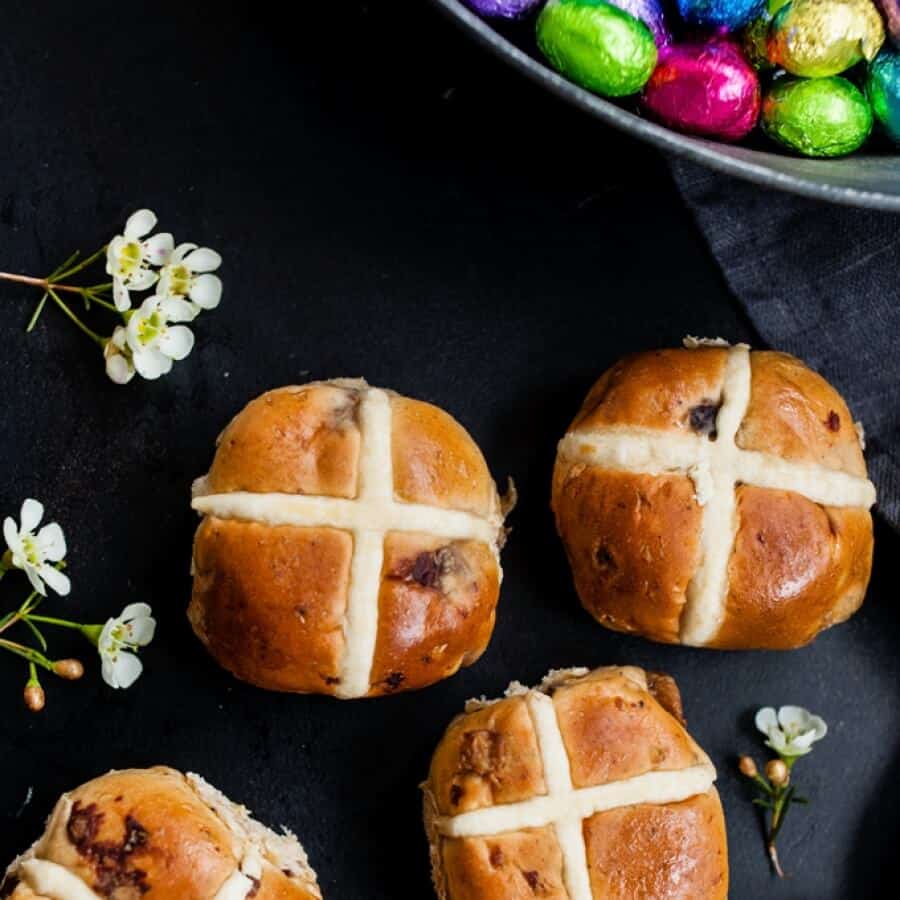Easter is generally a time of joy, often associated with Christian tradition. In the first centuries of the Christian era, Christmas and Easter were not associated with exact dates, but in the end both celebrations were fixed with dates that were similar to former pagan holidays. That also helped to build a following in Christianity‘s early years. Therefore Easter as a symbol of resurrection coincides with the springtime renewal of life in nature and life in general. Either which way, in different corners of the world many Easter customs have grown up, and that includes Easter treats. In our redaction we have prepared for you a few traditional recipes from different countries.
Hot cross buns, UK
Similar variations on sweet bread exist in other European countries such as Mazanec in the Czech Republic or Tsoureki with coloured eggs in Greece
Ingredience:
2 sachets dried yeast or equivalent of fresh
450 g bread flour (that will provide a difference in color to contrast with the white cross)
50g of white flour
200 ml semi-skimmed milk
1 large egg
50 g unsalted butter
1 teaspoon cinnamon
½ nutmeg
55 g sugar
50 g raisins
30 g dried cranberries
2 tablespoons mixed peel
honey to glaze
Process: Pour warm milk on the yeast and stir it to combine, then leave it to rise. Meanwhile melt the butter. Combine the yeast mixture with egg, butter, spices, salt, sugar, raisins, cranberries, and bread flour into a dough. When the dough is nicely worked out, leave it in a warm place for about an hour to rise again. It will change in volume rapidly. After that preheat the oven to 180 – 190 C. Divide the dough into small buns and roll them into small balls. When the buns are ready, mix a little bit of white flour with water, stir with a spoon to create a thick paste, which will be placed carefully over the top using a spoon or piping bag. Bake for 20 minutes. Glaze them with runny honey while hot.
Pashka, Russia
Ingredience:
850g ricotta cheese
250ml cream
150 g softened butter
3 egg yolks
125g caster sugar
1 tsp vanilla essence
100g chopped Mixed Peel
100g blanched almonds, finely chopped
Process: First you prepare the form for the Pashka. Line chosen pyramid-shaped cup/cups with muslin. Beat the butter in a processor and slowly add ricotta. Meanwhile heat the cream. Whisk egg yolks with sugar in a bowl until the mixture is thick and gradually start pouring warm cream, while whisking. Then return back to medium heat and rather warm it up for 5 – 7 min, but don’t boil it. After that cool the ready mixture and stir in vanilla essence, peel and almonds plus the ricotta/butter from earlier. Divide into prepared cups and press down with spoon until nicely filled. Keep refrigerated over night. Then you turn them upside down and get them out of the cups, remove muslin.
Chipa, Paraguay
Ingredience:
550g yucca flour ( Yucca flour comes from Yucca root [Manihot esculenta] also cassava. It is a gluten free flour, used for making bread or as a thickener)
225g corn meal
1⁄2 tsp. baking powder
1 1⁄4 tsp. salt
4 eggs
anise seeds
100 ml milk
100 ml unsalted butter
1 tbsp. anise seeds, lightly toasted
170 g shredded mozzarella
55 g grated parmesan
75 g crumbled feta
115 g shredded cheddar
Process: Mix yucca flour with corn meal and baking powder with salt. Add sliced butter until it starts binding together, then add eggs and milk and whisk it until you make a nice dough. Then come cheese and anise seeds to form a final ball. Divide it into small pieces (about 14 – 16), and cool them for 30 minutes. Oven should be preheated to 200 C. Take each piece of dough and form into a 15 cm long roll and connect the ends together. Place them into prepared baking sheet and bake 15 minutes until they are puffed and golden.
Paçoca de Amendoim, Brazil
Ingredience:
340 g peanuts, lightly salted
280 g brown sugar
170 g manioc flour or manioc starch
pinch of salt
60 ml condensed milk
Process: Grind peanuts and sugar and mix them with manioc flour and salt. Start adding condensed milk spoon by spoon and keep checking if the mixture comes together. The formed dough can be either pressed into a prepared pan with baking paper and after removing from pan cut into pieces or use cookie cutter of your choice. Store in container.
Easter Cake baked in form of lamb, Czech republic
Lambs and eggs are two major symbols of Easter. A sweet treat in the form of a lamb is a traditional item in the Czech Republic, where one cannot imagine Easter without it. The cake can be made in any of your favorite forms.
Ingredience:
170 g flour
170 g caster sugar
170 g butter
baking powder
3 eggs
Process: First prepare the form using a layer of butter and pour with flour. Separate yolks from egg whites. Whisk the egg whites with a pinch of salt and a spoon full of water into a firm foam. Meanwhile mix yolks with sugar and gradually pour melted butter. Last comes flower with baking powder. At the end mix the final mixture with the egg white snow (here you don’t use a processor, but gently stir it not allowing the snow to drop. Pour into a form and bake in preheated oven 180C for about 30 minutes. Check with a wooden skewer. After removing from the form and cooling down, sprinkle it with fine sugar and tie a ribbon around its neck.
What do you think, will you prepare a traditional dish of your own or will you try something new this year?
Photo: Shutterstock
Support us!
All your donations will be used to pay the magazine’s journalists and to support the ongoing costs of maintaining the site.
Share this post
Interested in co-operating with us?
We are open to co-operation from writers and businesses alike. You can reach us on our email at [email protected]/[email protected] and we will get back to you as quick as we can.










